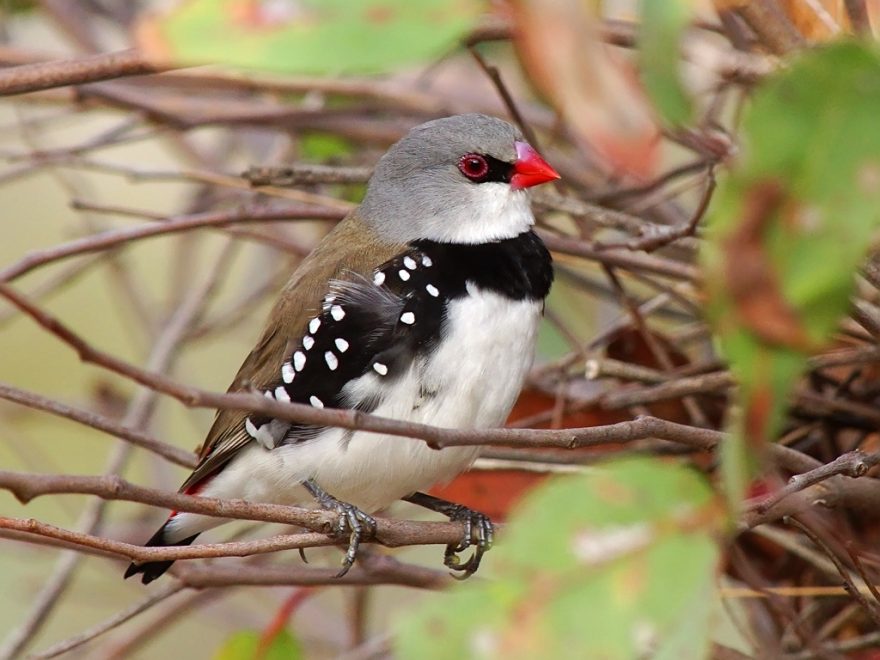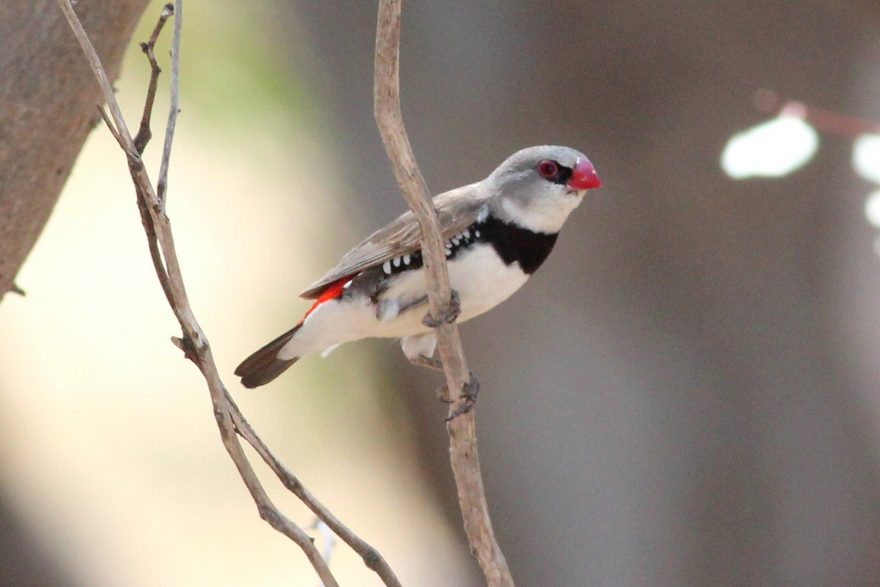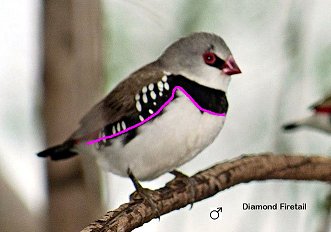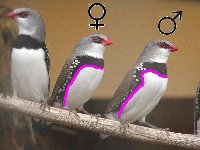The Diamond Firetail finch — known also as the Diamond Sparrow — is a medium-sized grass finch found in south-eastern Australia in South Australia, Victoria, New South Wales and southernmost Queensland. They live in large flocks, often among other grassfinch species, but break into pairs or small groups during the breeding season.
The Diamond Firetail’s striking coloration make them popular in aviculture, however their assertive behavior, difficulty to sex, and (in some Australian states) strict licensing requirements make the species unsuitable for beginners.

Housing & Compatibility
Diamond finches are considered to be a moderately aggressive species, however the severity of this aggression does differ significantly between different individuals and pairs. The more aggressive birds will need to be housed as single pairs or small colonies of other large finches, such as Cutthroats, Chestnut-breasted mannikin, Java sparrows, or true finches like goldfinches, greenfinches, song sparrows, and canaries.
Diamonds that show less aggression can generally be housed with other placid finches in a large mixed collection. Providing a large aviary with many hiding places and nesting sites is the best way to keep aggression under control, but in this situation it’s still necessary to monitor the Diamonds carefully and separate them if issues arise.
Best breeding results are attained in a large planted aviary. Breeding in a smaller aviary or cage is generally unsuccessful.
Diet & Feeding
A quality seed mix including canary seed, various millets and panicum forms the basis of the Diamond finch’s diet. Seed lacks many essential vitamins and minerals which must be compensated for by introducing other foods. Sprouted seed increases the nutritional value of seed and is a cheap way to improve your birds health. Freshly grown green seed heads should also be offered frequently; especially during the breeding season.
Fresh fruit, vegetables and leafy greens will usually be consumed by these birds. Kale, bok choy, endive and silverbeet are the most nutritious and will be readily eaten. Spinach can also be given, but only sparingly as it can contribute to calcium deficiency.
Live food is an essential part of the Diamond Firetail’s diet and is a requirement if you’re intending to breed them. Mealworms, maggots, termites, and small crickets can be offered.
Do not feed anything from the list of forbidden foods.

Breeding
Diamond finches will breed throughout the warmer months of the year, but most productively in late spring and early autumn. Birds should be at least a year old when permitted to breed, however they should be paired up as young as possible to ensure a strong pair bond. Adults can be re-paired with a different bird, but it may take some time for them to commence breeding.
They prefer to construct their own nest in a dry shrub or brush using fine grass and feathers. Half open nesting boxes may also be accepted. They like to build a very large nest, so a significant amount of nesting material should be provided. Nest inspections are not tolerated.
They typically lay 4-7 eggs in each clutch, which are incubated by both parents for approximately two weeks. Young birds fledge the nest at three weeks of age and are usually independent a month later. Young birds can generally be left with their parents without issue.
Sexing
Diamond firetail’s have a reputation for being very difficult to sex. There are many different methods proposed; including tail coloring, head size and shape, listening to the birds call one another (hens are raspier), DNA sexing, or simply putting a large group together and hoping pairs emerge.
One particularly interesting method was devised by Danny Searle in 2010. He hypothesized that the white breast is perfectly curved in hens, but juts outwards towards the wings in males. See the images below.
 |
 |
Mutations
A few mutations have been established, including cream, white (pied) and pure white (albino). Pure normal birds are still readily available.
Health
A strict worming and parasite control regime is essential to ensure the long-term health of any finch collection. Diamond finches can be expected to live for 7-10 years.
Diamonds will spend a lot of time foraging for food on the aviary floor, making them more susceptible to parasites and diseases that spread via droppings. Regular cleaning and preventative healthcare is a must.